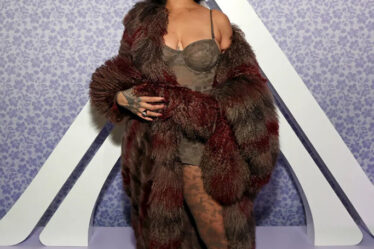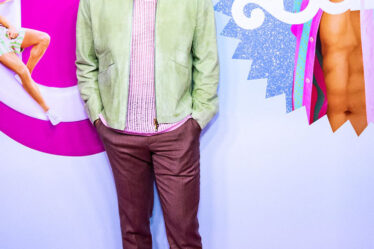
This feature appears in V139, Supermodel, Superhero issue, now available for purchase.
For his Spring 2023 Ready-to-Wear Collection, Victor Glemaud held his showing at Flipper’s Roller Boogie Palace at Rockefeller Center. Finding inspiration from what he calls the “Titans” of American design, such as Donna Karan and Bill Blass, Glemaud created a collection full of modern and effortless sportswear designs. The collection was created with a simple color palette; black, powder pink, white, cream, and a statement leopard print pattern. Glemaud’s designs are no-nonsense, he doesn’t need to rely on kitsch in order to grab attention in the New York fashion scene.
In his experimentation with knitwear, so luxurious it could be mistaken for a sewn garment, Glemaud delights in an idea of simplistic modern luxury, a market that he has clearly become an expert in. The designer sat down with V to discuss his SS23 collection, the current state of New York Fashion Week, the power of community, and the expanding world of Victor Glemaud.
Read the exclusive interview below.
V MAGAZINE: First off I have to congratulate you on such a beautiful show.
VICTOR GLEMAUD: Thank you so much.
V: Can you just walk us through some of the points of inspiration for the collection this season and where you pulled from?
VG: It was actually sort of an interesting mixed bag of things. I took this trip to Harbor Island with my husband where I hadn’t been since before the pandemic and it was just so great. The food, the people, and the whole thing was just so beautiful. It was truly impactful to return and see the island arriving by boat. That was really the color inspiration for the collection. And in terms of the silhouettes and proportions, we were looking at a lot of American sportswear—what I call—”Titan designers” at the museum at FIT like Giorgio Sant’Angelo, Stephen Burrows, Bill Blass, and Donna Karan. We were just taking things from their vocabulary, at the museum we couldn’t touch anything, but we got to see the inside and outside of the garments and feel their weight. It was just so nice to see those clothes that I’ve seen in books, in pictures, and on social media, up close and personal. So it was really those two main points of inspirations and the idea of what knitwear is today, which is always what I’m thinking about.
V: I think that those points of inspiration definitely come through as you look at the collection.
VG: I hope so!
V: Can you talk a bit about the process of designing it as well? The process of creation and what that experience was like for you?
VG: For last fall and this season, we’ve sort of expanded the collection with these ponte dresses and matte jersey and scuba fabrication. So for me, it’s really this exploration of how do I combine these new fabrics with our knitwear offerings and have it all feel like one thing. I try really hard to have it be a cohesive collection and when you’re looking at it, you’re like, “Oh, well is that like a fully fashioned sweater dress or is that a sewn dress?” I think playing with these materials and really having it feel like one is an incredible challenge to me. I like that juxtaposition of, do I see the difference? Will people see the difference? And that’s really where we look at it. Obviously, it’s always sort of a reaction to last season or maybe a continuation of the season before. I feel like the last three collections that we’ve shown on the runway since lockdown, they’ve been really modernist. Minimalist, if you will, in terms of color and in terms of pattern mixing. That was and is very intentional. I just really like the idea of pushing what we do creatively in terms of design, but also having people understand it and see it on a runway and these different fabrications moving as well. It feels like an interesting challenge right now that I’m really enjoying.
V: I think the location of the show was brilliant. Probably one of my favorite locations for New York Fashion Week this season. Why did you choose this location in particular and how does it relate back to the broader theme of the collection or even the brand ethos itself?
VG: I think you just tapped on all of those things. The clothes, myself, the brand, it’s all about joy, New York, history and this idea of inclusion where all of the runway shows we’ve done have been in public places, that is very intentional. I like mixing my friends, my family, my fashion family all together. They’ve known each other for years. So I take that spirit and put it into these shows so it’s not this distant idea of a fashion show or a part of fashion week that people can’t access. The idea of Flipper’s at Rockefeller Center is quite honestly the greatest sort of illustration of that. On a beautiful Saturday, we were able to show outside in a fashion week that felt like a fashion week pre-pandemic.
There was a lot happening in the city. It was back to school, and a lot of different things were happening simultaneously. I think this season truly felt like the culmination of the two shows prior to that. From the collection to the clothes to incorporating my home partnership with Schumacher to the eyewear partnership that we have with Tura. This show was able to show the world that we have been building over the last couple of years in one cohesive place to the invited audience, but also to people who were just walking by.
I saw people who were there earlier during our rehearsal who were at the show and that says something for New York Fashion Week and fashion in general. I feel it is something that people want to see and people want to try to understand. And I hope the way we show our collections and continue to show it, allows us to reach a broader audience.
V: Leaning a bit more into like your roots in New York, it’s about history. It’s about just creating the space where, you said it yourself, even the public can access and have access to something that has been seen as exclusive. Can you tell me a bit about your upbringing in New York and how else you feel that runs through the veins of your brand and maybe even your earliest fashion influences?
VG: Absolutely, they absolutely do. I am very much a New Yorker. I’m impatient and I don’t know how to drive. I grew up in Queens and I started coming to the city on my own when I was in middle school. I would go to events, [outings], and museums with my parents, not frequently, but enough where I understood where I was. the idea of Rockefeller Center, which is something that I’ve been working on securing since March of this year…
V: Wow. It’s been that long in the making?
VG: Oh yeah, absolutely. It just felt right and luckily I have been working in fashion since I was 19 when I was going to FIT studying fashion. I started interning and I became the design assistant to Patrick Robinson, who is my great fashion influence, one of my best friends, mentor, big brother, the whole thing.The collections and the shows now are me putting my personal story, my history in growing up in New York, starting to work in New York, and starting to work in fashion, into these shows. I really have enjoyed the narrative aspect of that. Prior to this it was presentations and imagery, where it’s just clothes on a great person and we build a story around that.
But when it’s moving, when you’re in a location, it becomes bigger than that, you know? It has allowed me to be more personal and I have enjoyed that. I think it creates a more well rounded collection because yeah, some people want to know about me. Through these shows I can naturally tell a story and link it back to where I grew up, where I was born, who my influences are, and who are the people that I find personally stylish. All of these things are thrown into it and it might be a nod or a gesture or whatever it is, but it’s all really there. Even going back to the choice of days we choose to show, I always wanna show on a Saturday, because again, I can have my family there, I can have my friends there. It feels more like coming to my house for dinner than if I was to show on a Wednesday at 9:30 AM.
V: Yeah, I love that. And then to finish off, you kind of started touching on this, but I do wanna step into it a bit more; the realm of New York Fashion Week. I feel like there’s been such a shift over the years. I just think that a lot has changed, we’re seeing more designers of color, we’re seeing more people challenge the norms of what New York fashion has been for the past few years. So I just want your take on that and I feel like you’ve built such a community in your brand, from your team members to the people who actually wear the clothing. It’s more than a brand, it’s more than a fashion house…I feel like it is a community. So I just want to hear your take on the landscape of New York Fashion Week and designers that occupy the space now in general.
VG: First off, thanks for saying that and noticing that, it does feel like that and you know, it’s not something that we shout from the rooftops, but it’s just really organic, and it’s the way I live my life. So it’s a part of the brand, you know, as the foundation of the brand in a way. I think what is happening in New York Fashion Week are brands that have that ethos where they are truly sticking to their point of view are bubbling up and getting recognition from press, social, and from sales. That’s really important. I think this is the beginning, it’s not fully sorted out yet. I think there’s a lot of work to be done in New York and the other fashion capitals for that matter, but it’s the beginning of that.
I think in terms of a support system, designers are truly looking out for one another. I have never seen that before in the couple of decades that I’ve worked in fashion. There is this comradery that I think the pandemic and lockdown allowed us to form. When it comes to designers of color, black designers, there are designers doing different things but we still support each other. I was at this dinner at the end of fashion week and I sat across from Sergio Hudson, and Laquan Smith was there and we were all yapping, chatting and talking business and complaining. But overall, it was like, “I like what you do, I like what you do and I like what you do, Keep doing it.” And I think that support system is vital to our growth.
Whether you are an emerging brand, whether you’re selling to however many stores or you are selling to one store and are direct-to-consumer, I think there is support for one another that is incredible. I’m really happy that I can help and advise and direct people on what’s happening or the way I think things are happening. So I want to continue doing that because it’s really important for New York Fashion Week, for the industry at large and for what we are all trying to do, which is build long term businesses.



